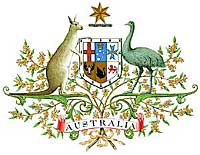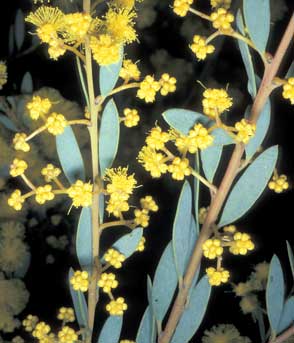The first granting of armorial bearings to Australia was made in 1908 by King Edward VII, but this did not feature Wattle. A new design, which is the one used in today’s Coat of Arms, was granted under Royal Warrant by King George V on 19 September 1912. This new design incorporated symbols of the six Australian States on a shield supported by a kangaroo and an emu; the border of the shield symbolizes the union of the States into the Commonwealth of Australia which had occurred in 1901; the Commonwealth Star appears above the shield and a scroll reading“Australia” appears below the shield. A wreath of blue and gold appears under the Star; these colours are known as the ‘livery colours’ of the Arms.

Australian Coat of Arms. Activate link to enlarge. (Used with permission
of the Awards and National Symbols Branch, Department of Prime Minister
and Cabinet.)
Branches of Wattle (tied with a ribbon) frame the Coat of Arms as an ornamental accessory to the shield. The Wattle does not form part of the Armorial Bearings and was therefore not mentioned in the blazon (i.e. the official description of the Coat of Arms) but was depicted in the coloured illustration of the gazettal of the Bearings that appeared in the Commonwealth Government Gazette on 18 January 1913. The introduction of the Wattle into the design of the Coat of Arms was done on the recommendation of the then Prime Minister, the Right Hon. Andrew Fisher (see Sowden 1913, p. 11). A reason for including Wattle was that species of this genus occur throughout Australia (thus a symbol of unification).
The Wattle depicted on the Coat of Arms appears to be a stylized illustration. It may not represent any particular species but does appears to have some characters consistent with Acacia buxifolia subsp. buxifolia or one of its relatives. It certainly is not a botanically accurate representation of A. pycnantha (Golden Wattle) which is now the official Australian floral emblem (but was not in 1913). The drawing shows a species with clusters of spherical, yellow flower heads arranged in racemes and having short, green phyllodes.

Acacia buxifolia subsp. buxifolia (Photo: B.R. Maslin)
Further information on the Coat of Arms, its history, discription and conditions governing usage are provided at the Prime Minister’s website and by the Awards and National Symbols Branch of the Department of the Prime Minister and Cabinet in their beautiful book Australian symbols, or by visiting their It’s An Honour website.
References
Anonymous (2000). Australian symbols, pp. 63. (A book published and produced for the Awards and National Symbols Branch of the Department of the Prime Minister and Cabinet.)
Sowden, W.J. (1913). Outline History of the Wattle blossom celebration in Australia. History of the Wattle Day movement. (Published for the Australian Wattle Day League and printed by W.K. Thomas and Co., Adelaide.)